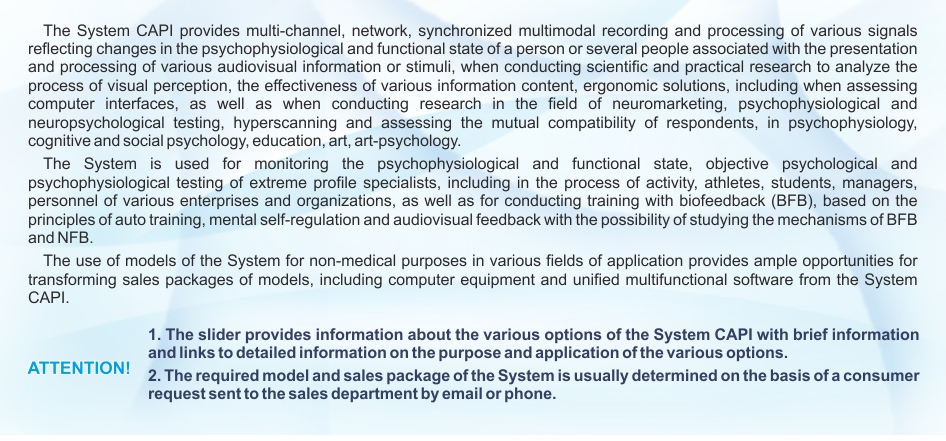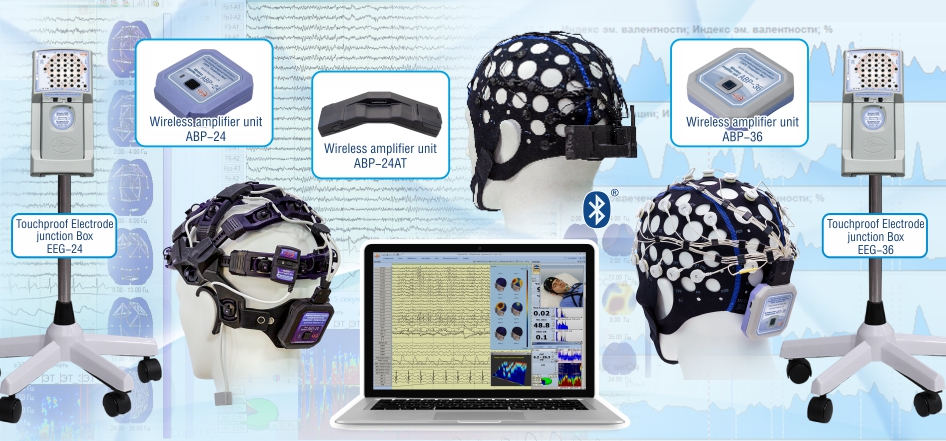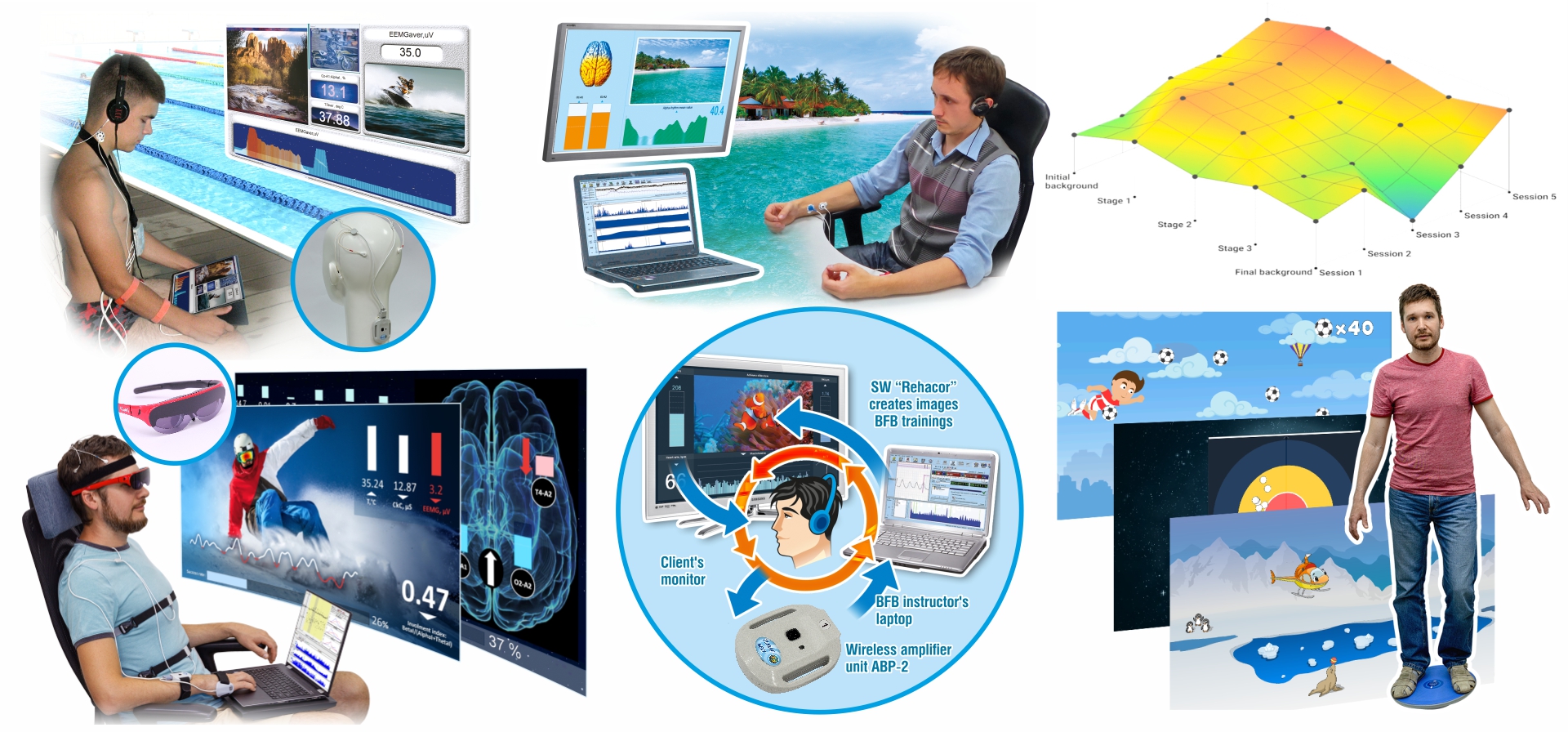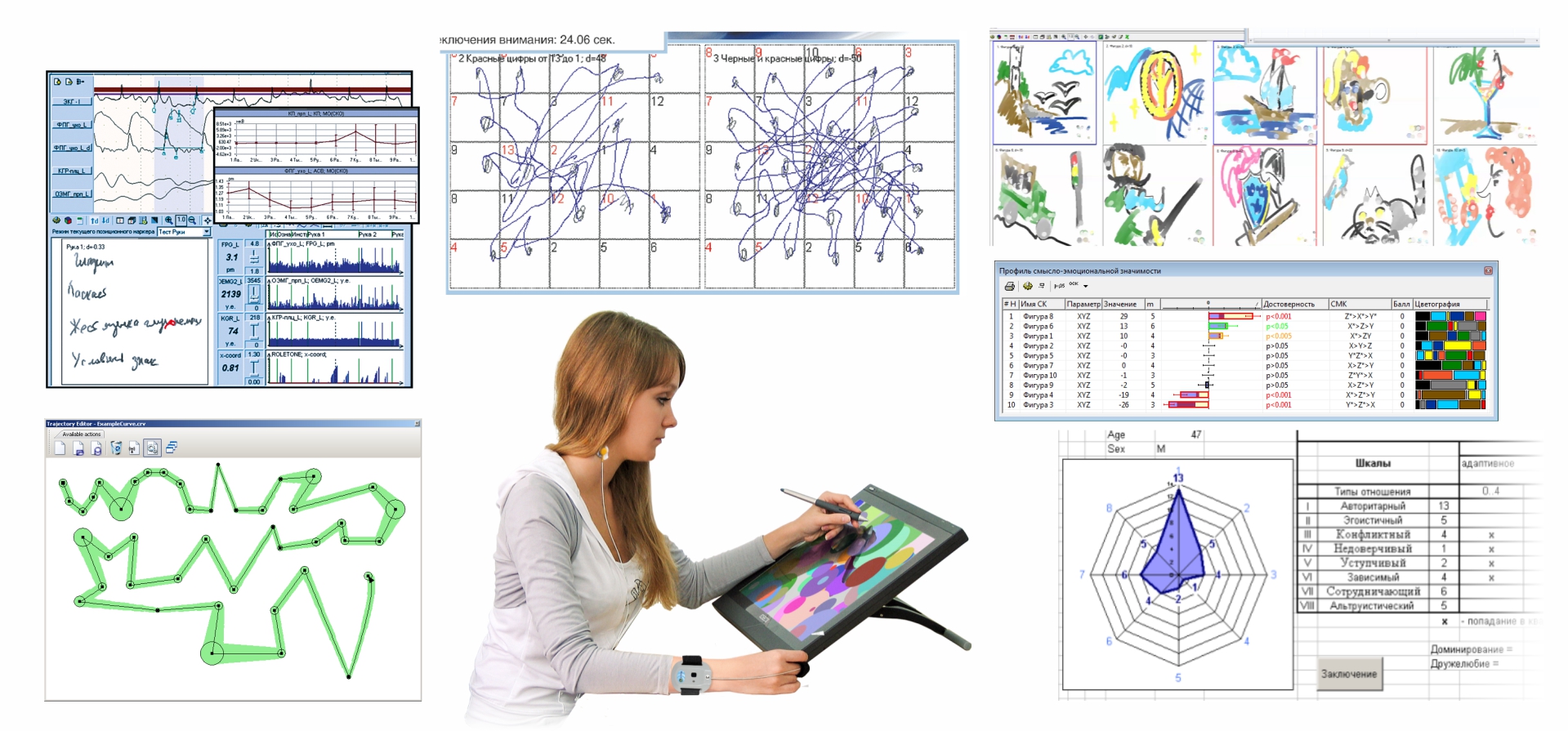ООО НПКФ «Медиком МТД»: Медицинское оборудование для диагностики, нейрофизиологии и реабилитации
Тел.: (8634) 62-62-42, 62-62-43, 62-62-44, 62-62-45.
www.medicom-mtd.com
The System CAPI models – Egoscop-Next, Rehacor-Next, NFB, BFB-Universal, BFB-Universal-I, Encephalan-Next-24, Encephalan-Next-24-AT, Encephalan-Next-36.

Scientific research using software from the System CAPI
(models Encephalan-Next-24, Encephalan-Next-24-AT, Encephalan-Next-36)

Scientific research in the hyperscanning paradigm - paired studies with analysis of intracerebral and interbrain connections of clients, as well as somatovegetative parameters

One of the stages of a pair study in which clients try to predict their partner’s actions by showing an arbitrary number of fingers.
Study of “competitive” activity using the example of a computer game. The following are recorded: oculomotor activity from Eye Trackers АТV-1C, EEG, PPG, SkC.
Study of “competing” activity - playing chess. Oculomotor activity is recorded (eye tracker glasses ATV-2-200) and EEG from a neuroheadset.
“Interbrain connections” between clients in paired interaction (“eye contact”).
Researcher's workstation for conducting paired experiments with data presentation and the ability to control the process.
Psychological and psychophysiological testing with synchronous analysis
of oculomotor reactions

Results of the analysis of statistical parameters. Table and ring diagrams for the number and duration of gaze fixations.
An example of a diagram of the distribution of oculomotor events according to the “zones of interest” of the test stage.
On the right is a testing area with an eye tracker and a client with sensors and electrodes. On the left is the researcher’s workstation.
Oculomotor events (fixations, saccades, blinks) in relation to time.
Templates for automatic spatial marking of “zones of interest”, distribution of stages according to test scales.
Profiles of scales based on the respondent’s direct answers and “indirect” characteristics of the dominance of visual attention (duration of fixations).
Table of calculated parameters of indirect signs of the respondent’s subjective attitude to tasks in relation to stages and scales.
Diagram of the average response time of the respondent on the test scales, characterizing the respondent’s indirect attitude to the tasks performed.
The System “Rehacor-Next” ensures effective development
of psychophysiological self-regulation skills

The System allows you to conduct BFB training in a convenient place, which is especially effective in sports, professional medicine and educational technologies.
A desktop option for training the psychophysiological state, as well as for correcting various psychosomatic disorders.
Assessing the success of subjects completing BFB training scenarios during a session or training course provides objective information about the dynamics of mental transformation.
A library of original trainings with BFB/NFB and a variety of audiovisual BFB images allow you to increase motivation for the psychophysiological transformation of your condition.
Training on a balance platform serves to strengthen the sense of balance in both children and adults, as well as improve coordination of movements, strengthen the muscular corset of the spine and leg muscles, and improve athletic performance in various sports.
The System “Encephalan-Next-24” model for studying the functional state (FS) of a person in the process of performing operator activities

The use of “heat maps” and the Scan Path mode makes it possible to evaluate the sequence of gaze directions and the distribution of visual attention of the dispatcher in the process of viewing operational information.
“Heat maps” illustrate the distribution of the dispatcher’s visual attention between 3 monitors.
Scan Path mode reflects the movements of the dispatcher's gaze between different areas on three monitors.
Dispatcher's workstation. Oculomotor activity is recorded using ATV-2-200 eye tracker glasses and psychophysiological data using a neuroheadset.
Information for the researcher: video from the “scene camera” (what the dispatcher sees), the dispatcher’s eyes, recorded signals and trends in psychophysiological parameters, topograms of EEG rhythms and a map of intracerebral connections.
Researcher’s workstation with signals, calculated parameters, video stream from the “scene camera” and the current direction of the dispatcher’s view.
A report with the results of a statistical assessment of the parameters of the dispatcher's visual attention distribution.
The System “Egoscop-Next” for objective psychological analysis and testing

Physiological signals in the form of graphs and trends, tied to the moments of presentation of test tasks, for visual assessment of the test subject’s reactions.
Automatic documentation of the testing process allows you to analyze the trajectory of the stylus and evaluate the actions to search for specified numbers.
Using the Schulte-Platonov tables as an example.
The color preferences of the subject when passing a projective test are additionally reflected for analysis in the profile of semantic and emotional significance in proportion to the subject’s use of colors on the scales or test tasks.
A tablet monitor and a special stylus allow you to take into account the accuracy of the trajectory being reproduced by the subject.
An example of visualizing the scale of connection types based on the results of the test.
The System CAPI in various models and delivery options for scientific research in the field of psychophysiology with the analysis of oculomotor reactions
Presentation of recorded psychophysiological parameters and oculomotor reactions of the subject, as well as intracerebral connections at different stages of the study for analysis.
Eye tracker glasses ATV-2-200 and a neuroheadset with an EEG recording unit.
The System for neuromarketing research synchronized with the recording and analysis of oculomotor activity and psychophysiological data upon presentation of prepared videos reflecting the layout of goods on store shelves, etc.
|
Phones: |
Frunze str., 68, Taganrog, |
| © 1997-2024 Medicom MTD Ltd All rights reserved | |
